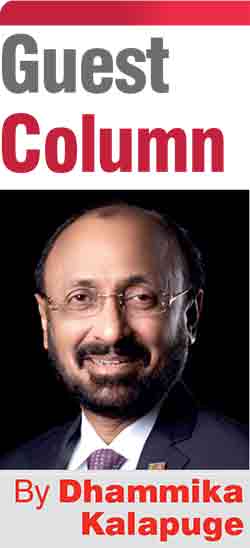Tuesday Dec 16, 2025
Tuesday Dec 16, 2025
Tuesday, 7 October 2025 00:59 - - {{hitsCtrl.values.hits}}

Organisations that want to prosper understand that creating a great customer experience is essential. It has to be a strategic approach that cascades down from the C-Suite to the front-liners. In reality, creating customer experience is not the sole responsibility of the customer service department. It is a culture set within the organisation, in which everybody in the entity consistently tries to create a unique experience of value that is highly appreciated by the recipient, who can often be any stakeholder. In today’s hyper-competitive marketplace, turning every employee into a brand ambassador is no longer optional. It is a critical mission, made possible through the contribution of every employee who has the right mind-set to do so.
In this Customer Service Week — ‘Mission: Possible’ — it should be considered a timely reminder to reflect and see whether the everyday actions taken by people across all functions create value for customers. Do we genuinely take care of the customer for their physical and mental well-being, saving time, money and effort on their part?
Possible by every role
 The front-liners or salespeople who deal directly with customers often make promises. These promises lead customers to form expectations. In fulfilling these expectations, a great deal of work has to be done by everyone, including the support staff. The support staff should also be aware that, at the point of delivery, living up to the expectations customers have formed is crucially important.
The front-liners or salespeople who deal directly with customers often make promises. These promises lead customers to form expectations. In fulfilling these expectations, a great deal of work has to be done by everyone, including the support staff. The support staff should also be aware that, at the point of delivery, living up to the expectations customers have formed is crucially important.
For example, although there may be no direct interaction with the end user, a support function such as a software developer who improves the user interface to make things easier for the customer enhances customer satisfaction. At a leading insurance company’s staff recognition ceremony, the Managing Director’s (MD) award was won by a junior executive from the Information Technology division. When asked by the compere, “Why do you feel you have won this prestigious annual MD’s award?” the recipient’s answer was very meaningful. He simply said, “When I design a solution, the primary factor I take into consideration is user convenience, irrespective of whether the party is internal or external.” There is a direct correlation: when employees feel connected to the mission, customers feel it too.
Possible empowerment – The key to ownership
One of the most powerful ways to transform employees into ambassadors is to give them ownership of customer outcomes. Employees should therefore be ready to Take Personal Responsibility (TPR) in their actions.
A strong example is The Ritz-Carlton Hotel, which globally empowers its staff to spend up to $2,000 per guest, without approval from management, to resolve any problem for their guests. The policy is less about the money and more about trust to achieve customer delight. It implies that employees are not simply following rules but stretching themselves to deliver the brand’s promise.
Making every employee a brand ambassador should be led by leadership. The C-Suite should consistently and repeatedly communicate that creating a great customer experience is everyone’s prime responsibility. Staff members who contribute immensely to this purpose with empathy, by leading without a title, and by providing an end-to-end solution should be recognised and rewarded
This kind of empowerment fosters a proactive mindset. Employees stop asking, “What’s my job?”—which confines them to the rule book—and start thinking, “What is the right thing for the customer I should do to create an experience?”
Often, superiors doubt whether such empowerment could lead to staff abusing it. However, research proves that if integrity is a core value of an organisation, and if utmost emphasis is placed on trustworthiness during recruitment, there are hardly any instances of misuse.
The Ritz-Carlton Hotel’s service credo is, “We are ladies and gentlemen serving ladies and gentlemen.” When the culture is set with such a philosophy, staff maintain harmony with each other, speak courteously, go all out to serve one another, and demonstrate genuineness in everything they do with pride.
Possible breakdown of silos
For this mission to succeed, companies must dismantle the invisible walls between departments. The departmental mind-set often works towards achieving the glory of the respective units. Such an approach can be blind to the requirements of other divisions of the organisation. The divisional mind-set should now transform into a Total Solution Focus (TSF) mind-set, in which every division works hand in glove with a Centre of Expertise mind-set, with the sole intention of achieving overall stakeholder delight.
Cross-functional meetings, shared metrics and integrated systems allow marketing, operations and service teams to work together, keeping the promise given to the customer in everybody’s mind. This alignment is essential in an era where, through social media, one poor experience can quickly go viral. Be mindful that when you blame another division, the shame and the claim remain within the organisation with severe consequences.
When an airline crashes, the easiest reaction is to pass the blame to pilots who are no more. However, rebuilding trust in the brand thereafter requires enormous effort and time.
Possible cultural shift
Making every employee a brand ambassador should be led by leadership. The C-Suite should consistently and repeatedly communicate that creating a great customer experience is everyone’s prime responsibility. Staff members who contribute immensely to this purpose with empathy, by leading without a title, and by providing an end-to-end solution should be recognised and rewarded.
Toyota Lanka Ltd., regularly recognises their best-performing branch. The best branch then shares its success story with the other 18 local branches, emphasising the best practices that led to monthly recognition. Moreover, these best practices are shared on a global platform. Such activities build tremendous enthusiasm amongst staff and inspire everyone across the company to create an outstanding customer experience.
When employees see their colleagues celebrated for living the brand values, others are also more likely to follow suit. The ripple effect is powerful: customers sense the alignment, loyalty deepens and advocacy grows.
For this mission to succeed, companies must dismantle the invisible walls between departments. The departmental mind-set often works towards achieving the glory of the respective units. Such an approach can be blind to the requirements of other divisions of the organisation. The divisional mind-set should now transform into a Total Solution Focus (TSF) mind-set, in which every division works hand in glove with a Centre of Expertise mind-set, with the sole intention of achieving overall stakeholder delight
Mission possible worth accepting
In 2025, the companies that achieve outstanding results will be those where every level—from the C-Suite to the lowest rank—works together with the shared goal of achieving an exceptional customer experience.
This mission is possible. It requires a strong belief in a sense of belonging, empowerment and deeper commitment, with the understanding that every role is a customer service role. When everyone performs their responsibilities to the best of one’s ability, they create great customer experiences. Making every employee a custodian of the brand is truly a mission possible for everyone who loves the organisation.
(The writer is a sought-after ‘Customer Experience’ specialist in Sri Lanka. Over the last three decades he has conducted nearly 3,500 inspirational and educational programs for over 800 organisations in 11 countries. His work can be seen at www.dhammikakalapuge.com.)